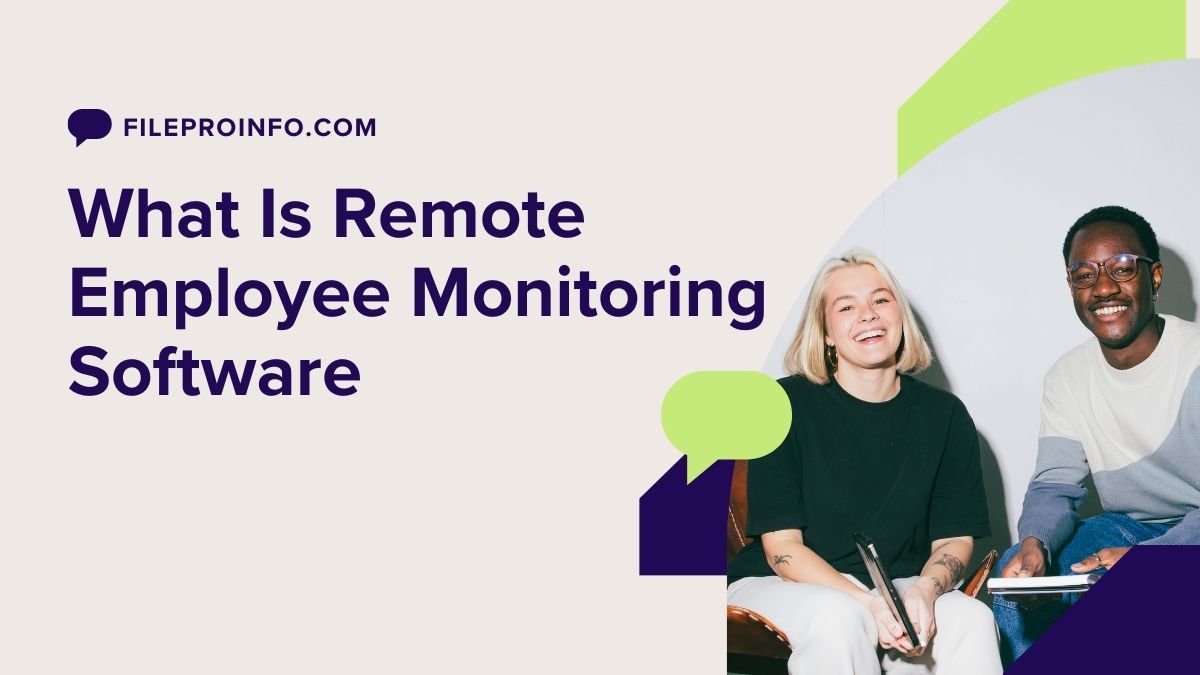
Remote employee monitoring software is a tool that allows employers to track and monitor their employees’ activities while working remotely. With the rise of remote work, this software has become increasingly important for businesses to ensure productivity and efficiency among their remote teams. By using this software, employers can monitor their employees’ tasks, track time spent on projects, and ensure that work is being done effectively and efficiently.
This software works by tracking and recording various data points, such as internet and application usage, screenshots of employees’ screens, and even GPS locations for employees who work on the go. This data is then compiled into reports and dashboards for employers to review and analyze.
The importance of remote employee monitoring software lies in the benefits it offers to both employers and employees. Some of these benefits include:
- Increased Productivity: By tracking employees’ activities and time, employers can identify any productivity gaps and take necessary steps to improve efficiency.
- Improved Time Management: With time tracking features, employees can accurately track their time spent on tasks, allowing for better time management and meeting project deadlines.
- Enhanced Security: This software can monitor and restrict access to sensitive information, reducing the risk of data breaches and protecting company assets.
- Better Project Management: By tracking the progress of tasks and projects, employers can ensure that work is being done effectively and make necessary adjustments to improve productivity.
In addition to these benefits, remote employee monitoring software also offers various features such as time tracking, activity monitoring, screenshots, internet and app usage tracking, and GPS tracking. There are different types of this software available, including time tracking software, productivity monitoring software, project management software, and employee feedback software.
Despite the benefits, there are some potential drawbacks to using remote employee monitoring software. These include the potential invasion of privacy, which can lead to employee mistrust and feelings of being micromanaged. To address these concerns, it is important for employers to follow best practices when implementing this software, such as clearly communicating the purpose and expectations, getting employee buy-in, using the software ethically, and regularly reviewing and adjusting its usage. By following these best practices, remote employee monitoring software can be a valuable tool for businesses to monitor and improve their remote teams’ productivity and efficiency.
What Is Remote Employee Monitoring Software?
Remote employee monitoring software is a valuable tool utilized by companies to monitor the activities and productivity of employees who work remotely. Its purpose is to track tasks, assignments, and internet usage in order to ensure efficiency and security. This software is beneficial in comprehending workflow and effectively managing remote teams.
When searching for remote employee monitoring software, it is important to prioritize features such as:
- time tracking
- productivity analysis
- data security
It is also helpful to look for user-friendly interfaces and compatibility with various devices to streamline remote work management.
How Does Remote Employee Monitoring Software Work?
- Installation: The remote employee monitoring software is installed on the employees’ devices, allowing for tracking of time spent on tasks and internet usage.
- Data Collection: The software collects data on both active and idle time, websites visited, and applications used by employees.
- Monitoring: Employers have the ability to view productivity reports, attendance, and task completion statuses through the software.
- Analysis: The collected data is analyzed to provide insights into employee performance and identify areas for improvement.
Pro-Tip: It is important to transparently communicate the purpose and use of the software to build trust and maintain positive employer-employee relationships.
Why Is Remote Employee Monitoring Software Important?
As remote work becomes increasingly prevalent in today’s workforce, the need for effective employee monitoring software has also grown. This section will delve into the importance of implementing remote employee monitoring software in your organization. From increased productivity to enhanced security, we will discuss the various benefits that this software can provide. So let’s explore why remote employee monitoring software is crucial for any company with remote workers.
1. Increased Productivity
- Set Clear Goals: Define specific, achievable targets for employees to increase productivity.
- Provide Resources: Equip workers with necessary tools and resources to streamline tasks and improve productivity.
- Encourage Breaks: Promote short breaks to prevent burnout and maintain high levels of productivity.
- Eliminate Distractions: Create a conducive work environment by reducing interruptions and distractions.
- Recognize Achievements: Acknowledge and reward increased productivity to motivate employees to continue performing at a high level.
2. Improved Time Management
- Set Clear Objectives: Clearly define specific tasks and goals to be achieved within set timeframes.
- Prioritize Tasks: Utilize time management tools to prioritize essential tasks and allocate appropriate time for each.
- Minimize Distractions: Encourage employees to create a focused workspace and limit non-work related activities during work hours.
- Regular Breaks: Promote taking short breaks to maintain productivity and prevent burnout.
- Provide Training: Educate employees on effective time management techniques and the use of time tracking software.
By implementing these strategies, organizations can successfully utilize remote employee monitoring software to improve time management, leading to increased productivity and efficiency.
3. Enhanced Security
- Implement robust access controls to ensure enhanced security and restrict unauthorized system and data access.
- Regularly update security software and encrypt sensitive information to mitigate data breaches and strengthen security measures.
- Conduct employee training on cybersecurity practices to reduce vulnerability to cyber threats and enhance security protocols.
- Enforce multi-factor authentication and strong password policies to further bolster system security.
- Perform regular security audits and assessments to identify and address potential vulnerabilities and improve overall security.
4. Better Project Management
- Clearly define project objectives to ensure they align with organizational goals.
- Utilize the project management features of the software to allocate tasks and set deadlines.
- Regularly monitor progress and promptly address any bottlenecks.
- Promote collaboration among remote teams by utilizing the software’s communication tools.
What Are the Features of Remote Employee Monitoring Software?
Remote employee monitoring software has become an essential tool for businesses with remote teams. But what exactly does this software offer? In this section, we will explore the key features of remote employee monitoring software that allow employers to effectively manage and monitor their remote employees. From time tracking to GPS monitoring, we will cover the various capabilities that these tools provide to ensure productivity and efficiency in a remote work setting.
1. Time Tracking
- Determine the purpose: Identify whether the time-tracking software is intended for monitoring productivity, billable hours, or project management.
- Choose appropriate features: Select a tool that offers real-time tracking, manual time entry, and integration with other management systems.
- Implement transparently: Clearly communicate the reasons for using the time tracking software, ensuring employees understand its benefits for both them and the organization.
- Educate and train: Provide comprehensive training on how to effectively use the software without creating extra workload.
- Respect privacy: Ensure that the time tracking software complies with data protection laws and respects the privacy of employees.
2. Activity Monitoring
- Set clear objectives for activity monitoring to align with performance goals and business needs.
- Establish transparent communication about the types of activities that will be monitored, ensuring employees understand the scope of the Activity Monitoring.
- Implement Activity Monitoring tools that provide insights into task completion, time spent on different tasks, and overall productivity.
- Regularly review and analyze the Activity Monitoring data to identify trends, efficiency bottlenecks, and areas for improvement.
- Utilize the data from Activity Monitoring to provide constructive feedback, recognize top performers, and optimize resource allocation.
3. Screenshots
- Enable feature: Activate the screenshot function in the monitoring software to capture relevant information.
- Set frequency: Determine the appropriate frequency for taking screenshots, taking into consideration the nature of work and privacy concerns.
- Notify employees: Clearly communicate the screenshot policy to employees, promoting transparency and understanding.
- Establish purpose: Clearly define the purpose of capturing screenshots, in line with productivity and security goals.
- Review and analyze: Regularly review and analyze the captured screenshots to assess productivity and ensure compliance with company policies.
4. Internet and App Usage Tracking
- Implement a clear policy: Clearly define what constitutes acceptable and unacceptable internet and app usage for employees.
- Provide training: Educate employees on the company’s guidelines for internet and app usage and the potential risks associated with inappropriate use.
- Use monitoring tools responsibly: Respect employees’ privacy while using tracking software, ensuring it complies with legal regulations.
- Establish transparent communication: Inform employees about the purpose and extent of internet and app tracking, fostering trust and understanding.
When implementing internet and app usage tracking, it’s crucial to balance oversight with respect for privacy and open communication to maintain a positive work environment.
5. GPS Tracking
- Inform Employees: Clearly communicate to your employees that GPS tracking is being implemented for their safety and to optimize travel routes.
- Obtain Consent: Obtain consent from employees before utilizing GPS tracking, ensuring compliance with privacy regulations.
- Training: Provide adequate training to employees on how GPS tracking works and address any concerns they may have.
- Transparency: Be transparent about how GPS tracking data will be used and assure employees that it will not be misused for monitoring personal activities.
A company has integrated GPS tracking to monitor employee travel for efficiency. This has improved route planning, reduced fuel consumption, and enhanced employee safety during field tasks.
What Are the Different Types of Remote Employee Monitoring Software?
When it comes to managing remote employees, it can be challenging to ensure that they are staying on task and completing their work efficiently. That’s where remote employee monitoring software comes in. There are various types of software available that can help employers track and manage their remote employees. In this section, we will discuss the different types of remote employee monitoring software, including time tracking, productivity monitoring, project management, and employee engagement and feedback software. Each type serves a specific purpose and can provide valuable insights into employee performance and productivity.
1. Time Tracking Software
- Install the time tracking software on all devices used by remote employees.
- Set up individual accounts for each employee to accurately track their working hours.
- Establish clear guidelines and expectations for the appropriate usage of the time-tracking software.
- Regularly review and analyze the data collected through the time-tracking software to identify any trends or patterns.
- Utilize the data to optimize work schedules and enhance overall productivity.
2. Productivity Monitoring Software
Productivity monitoring software is designed to track employees’ activities, providing valuable insights into their time management and task completion. This type of software offers a variety of features, including:
- Time tracking
- Monitoring of application and Internet usage
- Activity tracking
With this software, employers can easily identify inefficiencies, allocate resources effectively, and ensure that employees are focused on essential tasks. A helpful tip when implementing productivity monitoring software is to clearly communicate its purpose and benefits to employees in order to gain their trust and cooperation.
3. Project Management Software
- Choose project management software tailored to the specific needs of your remote team.
- Ensure the software integrates with other tools used for remote work, such as communication and file-sharing platforms.
- Train employees on how to use the Project Management Software effectively for task allocation, progress tracking, and collaboration.
- Maintain open communication with team members to address any challenges or concerns related to the Project Management Software implementation.
- Regularly assess the Project Management Software’s impact on project efficiency and make adjustments as necessary.
Considering the diverse needs of your remote team, selecting intuitive Project Management Software can significantly streamline operations and enhance productivity.
4. Employee Engagement and Feedback Software
In remote work setups, having employee engagement and feedback software is crucial for fostering a connected workforce and promoting constructive communication.
What Are the Pros and Cons of Using Remote Employee Monitoring Software?
As remote work becomes increasingly common, many employers are turning to remote employee monitoring software to keep track of their employees’ productivity. While this technology offers numerous benefits, it also raises concerns about privacy and trust in the workplace. In this section, we will delve into the pros and cons of using remote employee monitoring software and discuss the potential impact on both employers and employees. By the end, you will have a better understanding of whether this type of software is right for your company.
Pros:
- Increased productivity: Remote employee monitoring software can be a valuable tool in identifying and addressing productivity bottlenecks, leading to improved efficiency.
- Improved time management: It can assist in tracking the time spent on tasks, allowing for better time allocation and enhancing overall time management skills.
- Enhanced security: Monitoring employee activities, it can help safeguard sensitive company data and prevent security breaches.
- Better project management: It provides insights into employee work patterns, allowing for better project planning and execution.
Pro-tip: Make sure that the remote employee monitoring software complies with data privacy regulations to maintain trust and transparency within the organization.
Cons:
Some employees may perceive monitoring as invasive and hindering creativity and autonomy, leading to decreased morale and trust. It can also create a sense of micromanagement, hindering creativity and autonomy. Additionally, if not implemented carefully, it can lead to legal and ethical concerns.
What Are the Best Practices for Implementing Remote Employee Monitoring Software?
As remote work becomes increasingly prevalent, many companies are turning to remote employee monitoring software to track and manage their employees’ productivity. However, implementing this software requires careful consideration and planning to ensure its effectiveness and ethical use. In this section, we will discuss the best practices for implementing remote employee monitoring software, including clear communication, getting employee buy-in, and using the software ethically. By following these practices, companies can effectively monitor their remote employees while maintaining trust and respect in their working relationships.
1. Clearly communicate the purpose and expectations
- Initiate open and honest discussions about the reasons for implementing monitoring software.
- Outline the expected outcomes and how the software will be utilized to benefit both the company and employees, clearly communicating the purpose and expectations.
- Provide clear guidelines on the data that will be monitored and how it will be used to foster transparency and trust.
2. Get employee buy-in and address any concerns
- Conduct meetings to explain the benefits of the software and how it can support employees in their roles.
- Address concerns by actively listening to feedback from employees and providing transparent information about data usage and privacy.
- Offer training sessions to familiarize employees with the features of the software and demonstrate its positive impact on their work-life balance.
It’s crucial to acknowledge employees’ perspectives and involve them in the decision-making process regarding the implementation of monitoring software in order to gain their buy-in and address any concerns, ensuring a positive and productive work environment.
3. Use the software ethically
- Transparency: Clearly communicate the purpose and scope of monitoring to employees, ensuring they understand the reasons behind it.
- Consent: Obtain explicit consent from employees before implementing monitoring software, respecting their privacy and rights.
- Training: Provide comprehensive training on the ethical use of monitoring tools, emphasizing respectful and fair practices.
- Feedback: Encourage open dialogue and feedback from employees to address any concerns or issues regarding the software’s usage.
By utilizing monitoring software ethically, companies can foster a culture of trust and accountability within remote teams while maintaining a balanced approach to productivity and privacy.
Frequently Asked Questions
What is remote employee monitoring software and how does it work?
Remote employee monitoring software is a tool used by employers to track and monitor their employees’ activities and behavior while working in a remote or virtual environment. It collects data on employee activities, such as keyboard strokes, mouse movements, and website usage, and provides insights and reports to employers for data-driven decision-making.
What are the standout features of remote employee monitoring software?
The standout features of remote employee monitoring software include activity tracking, periodic screenshots, computer activity tracking, real-time monitoring, productivity tracking, and project budgeting. These features allow employers to track time, monitor employee productivity, and make informed decisions about workload distribution and project estimates.
What are some noteworthy features of remote employee monitoring software?
Some noteworthy features of remote employee monitoring software include live feeds, productivity charts, time and attendance tracking, clocking in and out, and detailed reports. These features provide employers with actionable data insights and reassuring proof of work from their remote employees.
How can remote employee monitoring software benefit a hybrid team?
For a hybrid team, remote employee monitoring software can help bridge the gap between remote and on-site employees by providing a unified user interface for tracking employee activities and productivity. This allows for better team collaboration and a fair assessment of performance for all team members.
What is the best use case for remote employee monitoring software?
The best use case for remote employee monitoring software is for organizations that have a large number of remote employees. This software can help employers keep track of their remote team’s activities, monitor their productivity, and ensure that they are meeting project deadlines and goals.
What are the pros and cons of using remote employee monitoring software?
Some pros of using remote employee monitoring software include increased productivity, better time management, and data-driven decision-making. However, some cons may include potential privacy concerns and the need for open communication and trust between employers and employees.




